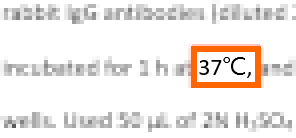|
This site is still under construction. Check back often to see updates. If you have any suggestions, use the contact form. |
Consistency
Consistency is essential for clarity. This section discusses consistency in language, formatting, and units.
|
If your paper was written by multiple authors, assign one author to check the whole paper for consistency. |
Language
Writing quality
Some papers have significant variation in English quality. For example, the Introduction is well written but the Discussion is full of mistakes. This is usually the result of multiple authors writing the paper. See the tip above.
Terminology
To make your paper easier to read and thus avoid reader frustration and confusion, use consistent terminology.
Example 1. Inconsistent terminology
|
In addition, the terminology in your paper should be consistent with that used in the literature. For example, if papers in your field use "self-assembling" when referring to nanosystems, do not use "self-arranging", even though the meanings are similar.
Using inconsistent terminology makes your paper difficult to read and difficult to find (e.g., for the example above, your paper will not show up in searches for "self-assembling").
Key verbs should also be consistent. For example, if your paper refers to a module being "activated", do not also use "triggered" if you mean "activated".
|
If you mean the same thing, use the same word; don’t make the reader guess. |
Spelling
Journals sometimes indicate whether they prefer US or British spelling. If no preference is given, choose one and use it throughout the paper.
Style
Your paper should follow a consistent style. For example, for lists of items, use either "A, B, and C" (Oxford comma) or "A, B and C".
Example 2. Inconsistent style
|
Formatting
Formatting should be consistent unless stated otherwise in the guidelines.
Fonts
The font size, font (Times New Roman, Ariel), and font style (bold, italic) should be consistent for a given type of text. For example, the main text might need to be 10-point Times New Roman, but figure captions might need to be 8-point Times New Roman and bold.
Section headings are often larger than the main text. First-level headings might need to be bold and second-level headings might need to be italic. See Headings below.
Example 3. Asian fonts
|
Indentation
There are generally three indentation formats:
-
Paragraphs are not indented.
-
All paragraph are indented.
-
All paragraphs except the first one in a section are indented.
Check guidelines for the required format.
In-text reference citation format
See Introduction.
Headings
There are several heading formats. Check guidelines for the required format.
|
|
Results and Discussion |
|
|
Results and discussion |
|
|
RESULTS AND DISCUSSION |
|
|
1. Introduction |
|
|
1 Introduction |
|
|
1 Introduction |
|
|
1 INTRODUCTION
1.1 Background
Equation format
Equation numbering and punctuation should be consistent. For more on equations, see the Equations section.
Table format
Table numbering (Table 1, Table 2, etc. or Table I, Table II, etc.) and captions should be consistent. For more on tables, see the Tables section.
Figure format
Caption numbering ("Fig. 1.", "Figure 1", etc.) and the figure and subfigure caption format should be consistent. For more on figures, see the Figures section.
Units
Make sure that units are consistent. For example, use "ml" or "mL", but not both.
Example 5. Mixing of "ml" and "mL"
|
When several units can be used for a parameter, choose one and use it throughout the manuscript. For example, use Kelvin or Celsius, but not both.
|
Reviewers complain about inconsistent units because they make comparison difficult. Use consistent units. |
For units, use x/y or xy-1, but not both.
Example 6. Inconsistent unit format
|

